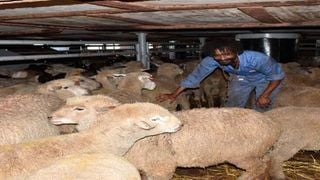
Farah-1 vessel crew holds some of the 13,000 sheep and goats destined for export to Oman at the port of Mombasa on January 3.
| Wachira Mwangi | Nation Media GroupSeeds of Gold
Premium
Vet on call: Why it is wasteful to export live animals
In the last few weeks I have received a number of enquiries on export of livestock to Middle Eastern countries and the Mauritius. The enquiries increased after a TV station aired a news item on a Kenyan shipment of mixed livestock to Oman.
The report indicated that the trader would export about 36,000 cattle, sheep and goats to Oman every two weeks. He was quoted saying that Oman had assured them there was a potential to export 500,000 livestock to the nation every year.
The media report said the featured animal cargo comprised 13,000 mixed livestock with an estimated value of Sh200 million. That sounded good business and possibly was one of the reasons the enquiries on livestock exports increased last week.
Most of the enquiries rarely translate into actual business because majority of people do not understand the complexities of dealing with live biological assets. It is a tough business.
I recall sometime in 2020, I had an enquiry for shipping 30,000 camels to a Persian Gulf nation. The trader and the potential buyer went to the extent of tabulating the total cost of the operation and concluded it was worthwhile. But the straw that broke the camel’s back was unavailability of a camel shipping vessel within the import timelines of the buyer. The camels never left their browsing fields.
Exporting livestock is a lucrative business but it requires military precision in logistical organisation. There are very many complex factors to consider starting from definition of the animals to be imported, number of animals, identification of the animals and health certification. All this happens before shipping overland, holding and sea transportation is considered.
Once a trader is interested in importing animals from Kenya, they seek possible exporters. Most of the export enquiries are for slaughter animals. I still insist that rather than export live animals, it would be much better for the country to enhance efforts in exporting meat, except where animals are required for rituals such as Haj.
You see, exporting live animals is very wasteful. For sheep, cattle and goats which are the most exported animals, approximately 40 per cent of the weight transported in the live animals is waste. This includes the skin, head, hooves, blood, urine, foetuses and gastrointestinal contents. It is much more economical and productive to export meat despite the requirement for cooling throughout the process.
By the way, the cost of cooling is much lower than the cost of feeding the animals and providing veterinary care during shipment.
Once an exporter gets confirmation of an order for live animals, the process starts with search and identification of candidate livestock throughout the country. The order quantity must be large enough to fill a sizeable ship and also be economical. I have heard people seeking to export hundreds of animals. That is not economical and the deals usually fail to materialise when the sellers realise such orders are not profitable if being shipped by sea. They are okay for short distance overland transport such as to or from neighbouring countries.
The most problematic issue with live animal exports is availability of the type and number of animals ordered for. I recall a cattle exporter who had been given an annual order of 12,000 cattle to be shipped monthly at the rate of 1,000. They were defined as castrated Boran steers of 400 to 500kg live weight and between 18 and 36 months old.
He supplied the first three lots and then the supply went dry. Kenyans must understand that export of slaughter animals requires a highly coordinated breeding, growing and finishing programme. The supply side must involve large numbers of well-trained out-grower farmers who understands the animal growth and export cycles.
The country must also consider that export animals must be the surplus after the domestic demand has been fulfilled. Otherwise, if we export large numbers of animals annually with the current population of livestock, unstructured production and increasing local demand for livestock products, we will surely find ourselves with no animals for local consumption.
The case of indiscriminate and high volume daily slaughter of donkeys that has driven them to the brim of extinction should serve as a warning that we must look deeper into the dynamics of livestock exports.
Kenya’s demand for livestock products was projected to grow in leaps and bounds between 2010 and 2050 in a publication by the Food and Agricultural Organization (FAO) of the United Nations. The report, whose highlight is presented in the table below, showed that beef demand would increase by 173 per cent by 2050 from 467,000 tonnes in 2010 to 1.3 million tonnes. This is equivalent to 1.9 million cattle slaughtered in 2010 and 5.1 million in 2050. Such demand would make livestock for export unavailable unless the country structures its livestock production to satisfy both the local and export markets.





